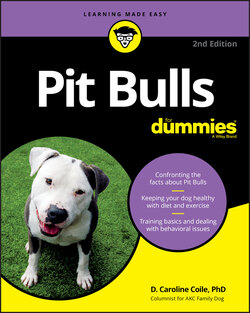Читать книгу Pit Bulls For Dummies - D. Caroline Coile - Страница 13
BULL-BAITING
ОглавлениеAlthough the role of canine gladiator was the most visible job for the tough dogs of ancient Europe, it was far from their most important one. A subtype of Molossian dogs known as Bullenbeissers, or German Bulldogs, were valued for their ability to control unruly cattle, earning their keep as butcher’s dogs. These dogs had to catch and grip escaping or uncooperative bulls on their way to market. The dog would hang on the bull’s nose, gripping the nose without letting go until the butcher could regain control. A good butcher’s dog could make the butcher’s job easy; a bad dog could be killed by the bull. As with all people who depend on their dogs, butchers were proud of their best “bulldogs” and anxious to prove them better than the neighboring town butcher’s dogs. So began the cruel practice of bull-baiting, in which a bull was tormented (sometimes for hours) not only for entertainment, but also in the mistaken belief that torturing the animal before killing it made its meat more tender. In fact, in some places selling meat from a bull that had not been baited was illegal. Bullenbeissers gave rise to the Boxer breed in Germany and to what would eventually become the Pit Bull in Britain.
Almost every town in England had a bull-baiting ring. One or two dogs were released, and they would attempt to grab the bull (which was usually chained to a stake) by the nose, often tormenting it for hours. The cruelties inflicted upon the poor animals (bulls and dogs alike) by people in the process were atrocious. In one well-known case, the owner of a dog demonstrated how courageous his dog was by cutting off each of her legs, one leg at a time, while she continued to drag herself to attack the bull. The dog was lost, but her offspring were in high demand.
As the Bulldogs or Bull and Terriers became known less for their bull-baiting skills and more for their fighting skills in the pits, they came to be known as Pit Bulldogs, or more simply, Pit Bulls.
The breed known today as the Bulldog or English Bulldog is not the same as the Bulldog of the eighteenth and nineteenth centuries. The earlier Bulldog strain is the ancestor of both the modern Pit Bull breeds and the modern Bulldog, but it was more similar to today’s Pit Bull than to today’s Bulldog. Many people still incorrectly refer to Pit Bulls as “Bulldogs,” though.
When English immigrants came to America, they brought with them their sport and their dogs. By the mid-1800s, dog fighting had a solid following in America. With the migration west, Bulldogs once again found themselves called upon to do the toughest jobs. They served as all-purpose farm and guard dogs, protecting families and stock from fierce wildlife, rampaging cattle, and marauding vermin. Many also served as hunting dogs, holding their own against bears, wolves, and on occasion, buffalo. Once again, the Bulldog underwent a metamorphosis — this time into a larger dog that could best serve these vital functions.
This variety of purpose is directly responsible for the great range in size of today’s Pit Bulls. An example of one possible size is shown in Figure 1-1.
FIGURE 1-1: Pit Bulls, because of their toughness, have been asked throughout history to do the tough jobs.
